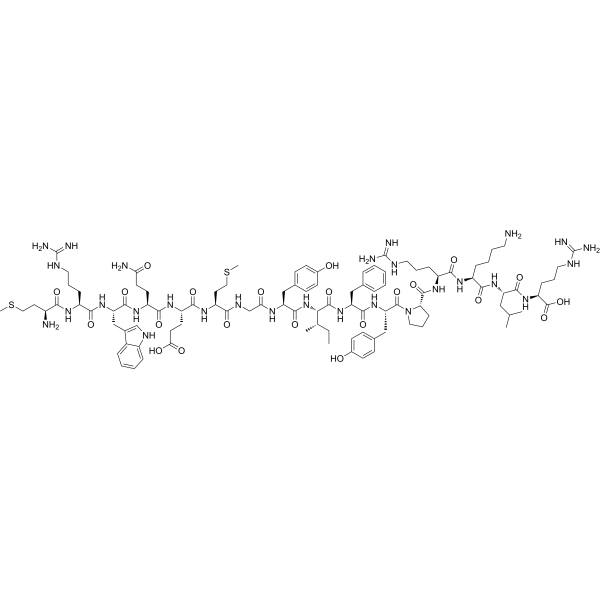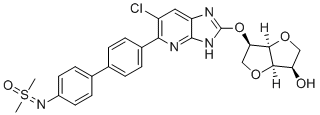| DC70496 |
HTH-02-006 |
HTH-02-006 is a potent, selective reversible inhibitor of NUAK1/2 with binding IC50 of 8/126 nM, respectively.HTH-02-006 reduces MYPT1(S445) phosphorylation in HuCCT-1 cells, suggesting NUAK1/2 inhibition.HTH-02-006 ameliorates YAP(S127A)-induced hepatomegaly, and reduces MYPT1(S445) phosphorylation.HTH-02-006 delays the outgrowth of YAP-induced HuCCT-1 xenograft tumors in nude mice.HTH-02-006 downregulated E2F, EMT, and MYC hallmark gene sets after NUAK2 inhibition in PC cells.HTH-02-006 slowed tumor growth and proliferation rates in a syngeneic allograft model and in radical prostatectomy patient derived explants.HTH-02-006 treatment led to inactivation of YAP and the downregulation of NUAK2 and MYC protein levels. |

|
| DC71255 |
MOTS-c
Featured
|
MOTS-c, a mitochondria-derived peptide (MDP), exerts antinociceptive and anti-inflammatory effects through activating AMPK pathway and inhibiting MAP kinases-c-fos signaling pathway. |

|
| DC71613 |
AMPK activator 7 |
AMPK activator 7 (compound I-3-24) is a an AMPK activator with the EC50 of 8.8 nM. AMPK activator 7 can be used for the research of diseases involving AMPK, particularly diseases such as type 2 diabetes, hyperglycemia, metabolic syndrome, obesity, hypercholesterolemia and/or hypertension. |

|
| DC71614 |
AMPK activator 6 |
AMPK activator 6 (Compound GC) reduces lipid content and activates the AMPK pathway in HepG2 and 3T3-L1 cells. AMPK activator 6 significantly suppresses the increase in triglyceride (TG) , total cholesterol (TC), low-density lipoprotein-C (LDL-C), and other biochemical indices in blood serum. AMPK activator 6 can be used for the research of non-alcoholic fatty liver disease (NAFLD) and metabolic syndrome. |

|
| DC71615 |
AMPK activator 8 |
AMPK activator 8 (Compound 2) is an AMP-activated protein kinase (AMPK) activator with EC50s of 11, 27, 4, 2, and 4 nM for rAMPK α1β1γ1, rAMPK α2β1γ1, rAMPK α1β2γ1, rAMPK α2β2γ1, rAMPK α2β2γ3, respectively. AMPK activator 8 can be used for the research of type 2 diabetes. |

|
| DC72235 |
Aldometanib |
Aldometanib (LXY-05-029) is an orally active aldolase inhibitor. Aldometanib can activate lysosomal adenosine monophosphate-activated protein kinase (AMPK) and decreases blood glucose. Aldometanib can be used for the research of metabolic homeostasis. |

|
| DC72738 |
YLF-466D
Featured
|
YLF-466D is an AMPK activator that inhibits platelet aggregation with IC50 of 84 μM. |

|
| DC74251 |
BI-9774
Featured
|
BI-9774 (BI 9774) is a potent pan-AMPK activator with EC50 of 64 nM in an ADP-Glo kinase assay with human AMPK (α1β1γ1) and EC50 of 8 nM in a cellular GLUT4 translocation assay. |

|
| DC74252 |
KI-301670 |
KI-301670 is a novel potent, specific NUAK1 inhibitor, disturbs NUAK1 signaling by targeting its ATP binding site, effectively inhibits the PI3K/AKT pathway in pancreatic cancer cells. |

|
| DC74253 |
MSG011 |
MSG011 is a potent, pan AMPK isoform activator with EC50 of 140.4 nM, 248.9 nM, 553.4 nM, and 472.9 nM for α1β1γ1, α1β2γ1, α2β1γ1, and α2β2γ1, respectively. |

|
| DC74254 |
PXL770 |
PXL770 is a novel orally bioavailable, small-molecule direct AMPK activator with EC50 of 16.2, 42.1 and 64 nM for α1β1γ1, α1β1γ2 and α1β1γ3, directly increases AMPK activity by both allosteric activation and protection from dephosphorylation. |

|
| DC74255 |
PXL770 monohydrate potassium salt |
PXL770 is a novel orally bioavailable, small-molecule direct AMPK activator with EC50 of 16.2, 42.1 and 64 nM for α1β1γ1, α1β1γ2 and α1β1γ3, directly increases AMPK activity by both allosteric activation and protection from dephosphorylation. |

|
| DC74256 |
RX-375 |
RX-375 (RX375) is an indirect small-molecule activator of AMPK by directly binds to Prohibitins (PHB1 and PHB2), induces dissociation of AMPK-PHBs complex. |

|
| DC74257 |
ZLN-024 hydrochloride |
ZLN-024 hydrochloride is a potent, allosteric AMPK activator that has no effect on mitochondrial function or the ADP/ATP ratio, directly activate recombinant AMPK α1β1γ1 and its homologue α2β1γ1 with EC50 of 0.42 uM and 0.95 uM, respectively. |

|













